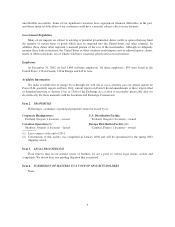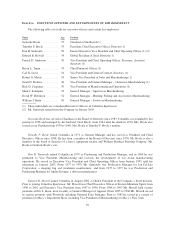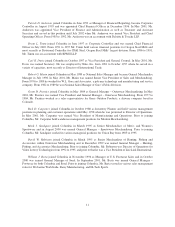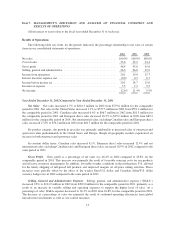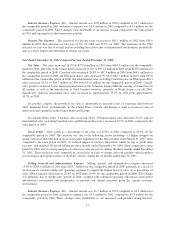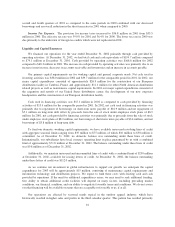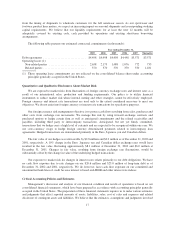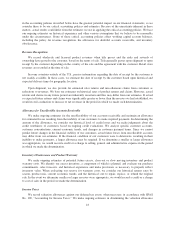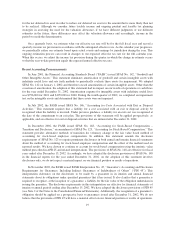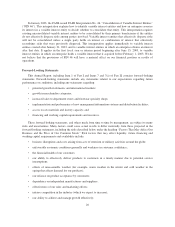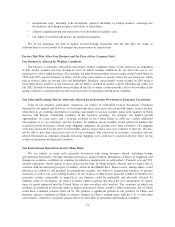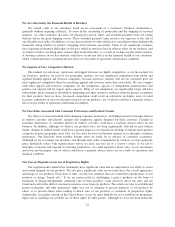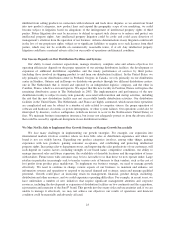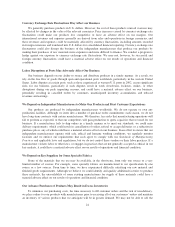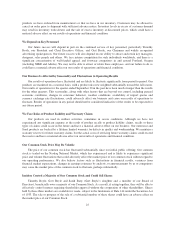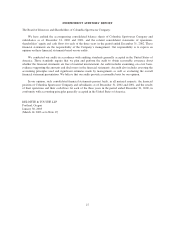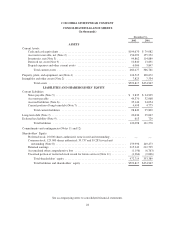Columbia Sportswear 2002 Annual Report Download - page 26
Download and view the complete annual report
Please find page 26 of the 2002 Columbia Sportswear annual report below. You can navigate through the pages in the report by either clicking on the pages listed below, or by using the keyword search tool below to find specific information within the annual report.for the net deferred tax asset in order to reduce our deferred tax assets to the amount that is more likely than not
to be realized. Although we consider future taxable income and ongoing prudent and feasible tax planning
strategies in assessing the need for the valuation allowance, if we have different judgments or use different
estimates in the future, these differences may affect the valuation allowance and accordingly, income in the
period we made the determination.
On a quarterly basis, we estimate what our effective tax rate will be for the full fiscal year and record a
quarterly income tax provision in accordance with the anticipated effective rate. As the calendar year progresses,
we periodically refine our estimate based upon actual events and earnings by jurisdiction during the year. This
ongoing estimation process can result in changes to our expected effective tax rate for the full calendar year.
When this occurs, we adjust the income tax provision during the quarter in which the change in estimate occurs
so that the year-to-date provision equals the expected annual effective tax rate.
Recent Accounting Pronouncements
In June 2001, the Financial Accounting Standards Board (“FASB”) issued SFAS No. 142, “Goodwill and
Other Intangible Assets.” This statement eliminates amortization of goodwill and certain intangible assets with
indefinite useful lives and sets forth methods to periodically evaluate these assets for impairment. We adopted
SFAS No. 142 on January 1, 2002 and therefore ceased amortization of certain intangible assets. Other than the
cessation of amortization, the adoption of this statement had no impact on our results of operations or cash flows
for the year ended December 31, 2002. Amortization expense for intangible assets with indefinite useful lives
was $796,000 for 2001 and $199,000 for 2000. During the fourth quarter of 2002, we completed an impairment
test on the intangible assets and determined that these assets were not impaired.
In July 2002, the FASB issued SFAS No. 146, “Accounting for Costs Associated with Exit or Disposal
Activities.” This statement requires that a liability for a cost associated with an exit or disposal activity be
recognized when the liability is incurred. Under previous guidance, a liability for an exit cost was recognized at
the date of the commitment to an exit plan. The provisions of this statement will be applied prospectively, as
applicable, and are effective for exit or disposal activities that are initiated after December 31, 2002.
In December 2002, the FASB issued SFAS No. 148, “Accounting for Stock-Based Compensation –
Transition and Disclosure,” an amendment of SFAS No. 123, “Accounting for Stock-Based Compensation.” This
statement provides alternative methods of transition for voluntary change to the fair value based method of
accounting for stock-based employee compensation. In addition, this statement amends the disclosure
requirements of SFAS No. 123 to require prominent disclosures in both annual and interim financial statements
about the method of accounting for stock-based employee compensation and the effect of the method used on
reported results. We have chosen to continue to account for stock-based compensation using the intrinsic value
method prescribed in APB 25 and related interpretations. The provisions of SFAS No. 148 are effective for fiscal
years ended after December 15, 2002. Accordingly, we have adopted the disclosure provisions of SFAS No. 148
in the financial reports for the year ended December 31, 2002. As the adoption of this statement involves
disclosures only, we do not expect a material impact on our financial position or results of operations.
In November 2002, the FASB issued FASB Interpretation No. 45, “Guarantor’s Accounting and Disclosure
Requirements for Guarantees, Including Indirect Guarantees of Indebtedness of Others” (“FIN 45”). This
interpretation elaborates on the disclosures to be made by a guarantor in its interim and annual financial
statements about its obligations under specified guarantees that it has issued. It also clarifies that a guarantor is
required to recognize, at the inception of a guarantee, a liability for the fair value of the obligation undertaken in
issuing the guarantee. The disclosure requirements in this interpretation are effective for financial statements of
interim or annual periods ending after December 15, 2002. We have adopted the disclosure provisions of FIN 45
(see Note 2 of the Notes to the Consolidated Financial Statements). Additionally, the recognition of a guarantor’s
obligation should be applied on a prospective basis to guarantees issued after December 31, 2002. We do not
believe that the provisions of FIN 45 will have a material effect on our financial position or results of operations.
19


